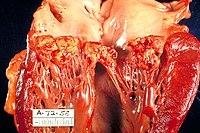
Photo from wikipedia
Background Fungal Endocarditis (FE), a relatively rare disease, has a high rate of mortality and is associated with multiple morbidities. Aspergillus endocarditis (AE) is severe form of FE. Incidence of… Click to show full abstract
Background Fungal Endocarditis (FE), a relatively rare disease, has a high rate of mortality and is associated with multiple morbidities. Aspergillus endocarditis (AE) is severe form of FE. Incidence of AE has increased and is expected to rise due to an increased frequency of invasive procedures, cardiac devices and prosthetic valves together with increased use of immune system suppressors. AE lacks most of the clinical criteria used to diagnose infective endocarditis (IE), where blood culture is almost always negative, and fever may be absent. Diagnosis is usually late and in many cases is made post-mortem. Late or mistaken diagnosis of AE contribute to delayed and incorrect management of patients. In the current study we aimed to describe the clinical, laboratory and imaging characteristics of AE, to identify predictors of early diagnosis of this serious infection. Methods Patients with definite/possible IE, as diagnosed by the Kasr Al-Ainy IE Working Group from February 2005 through June 2016, were reviewed in this study. We compared the demographic, clinical, laboratory and imaging criteria of AE patients to non-fungal IE patients. Results This study included 374 patients with IE in which FE accounted for 43 cases. Aspergillus was the most common fungus (31 patients; 8.3%) in the patient group. Lack of fever and acute limb ischemia at presentation were significantly associated with AE (p < 0.001, p = 0.014, respectively). Health care associated endocarditis (HAE) and prosthetic valve endocarditis (PVE) were the only significant risk factors associated with AE (p < 0.001 for each). Mitral, non-valvular, and aortotomy site vegetations, as well as aortic abscess/pseudoaneurysm, were significantly associated with AE (p = 0.022, p = 0.004, p < 0.001, and p < 0.001, respectively). Through multivariate regression analysis, HAE, PVE, aortic abscess/pseudoaneurysm, and lack of fever were strongly linked to AE. The probability of an IE patient having AE with HAE, PVE, and aortic abscess/pseudoaneurysm, but no fever, was 0.92. In contrast, the probability of an IE patient having AE with fever, native valve IE, but no health-care associated IE and no abscess/pseudoaneurysm, was 0.003. Severe sepsis and mortality in the Aspergillus group were higher as compared to the non-fungal group (p = 0.098 and 0.097, respectively). Thirteen AE patients died during hospitalization. PVE, the use of single versus dual antifungal agents, severe heart failure, and severe sepsis were significant predictors of mortality (p = 0.008, 0.012, 0.003, and 0.01, respectively). Conclusion To our knowledge, this is the first study to address diagnostic criteria for AE. Through multivariate regression analysis, absence of fever, HAE, PVE, and aortic abscess/pseudoaneurysm were strong predictors of AE. Use of these criteria my lead to earlier diagnoses of AE. Early treatment of AE patients with voriconazole in combination with other antifungal agents may be possible based on the previously mentioned criteria, which may facilitate better patient outcomes.
Journal Title: PLoS ONE
Year Published: 2018
Link to full text (if available)
Share on Social Media: Sign Up to like & get
recommendations!